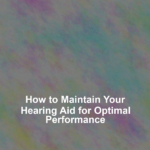Understanding the Essential Importance of Routine Maintenance for Hearing Aids
Enhance the Lifespan of Your Hearing Aids with Regular Care

Participating in routine checkups is crucial for significantly extending the lifespan of <a href="https://www.earwaxremoval.net/hearing-aids-are-getting-smarter-with-enhanced-technology/">hearing aids</a>. These practices facilitate early detection and resolution of any wear and tear before they develop into serious problems. As complex devices, hearing aids require consistent maintenance to function efficiently over lengthy periods. By committing to regular care, users can prevent minor issues from escalating into major repairs or replacements, which can be costly. Regular inspections and professional servicing of hearing aids can greatly improve their longevity, allowing users to enjoy the advantages of high-quality sound and comfort for many years.
To ensure the longevity of your hearing aids, consider adopting these effective maintenance strategies:
- Perform daily cleaning to remove dirt and wax accumulation.
- Store your hearing aids in a dry, safe environment when not in use.
- Regularly check batteries and replace them as necessary.
- Look for any visible damage, such as cracks or loose components.
- Use protective covers to shield devices from moisture and debris.
- Schedule professional cleanings and adjustments at least every six months.
By following these best practices, users can ensure their hearing aids remain in optimal condition, supporting their auditory health and allowing them to experience superior sound quality.
How Can Routine Maintenance Prevent Technical Issues?
Routine maintenance plays a pivotal role in the early identification and rectification of technical issues before they escalate into serious concerns. Many users may not realise that minor malfunctions can evolve into significant problems if left unchecked. Regular checkups allow audiologists to identify concerns such as faulty wiring, weak batteries, and software glitches that could hinder the functionality of hearing aids. By addressing these technical challenges proactively, users can avoid expensive repairs and ensure their devices operate optimally.
Some prevalent technical issues that may occur with hearing aids include:
- Corrosion and leakage of batteries.
- Blockages in microphones or receivers.
- Software malfunctions that require updates.
- Physical damage resulting from falls or moisture exposure.
- Challenges with wireless connectivity features.
- Feedback or whistling sounds indicating misalignment.
Being aware of these potential technical problems underscores the necessity for regular checkups, enabling users to avoid unnecessary disruptions in their daily lives.
Enhancing Comfort for Optimal Hearing Aid Experience
Proper maintenance of hearing aids is crucial for enhancing user comfort. When devices are well-maintained, they perform at their best, reducing the chances of irritation or discomfort that users might face. A poorly fitted or malfunctioning hearing aid can lead to physical discomfort, such as soreness in the ear or difficulty hearing clearly, which can severely impact quality of life. Regular checkups ensure that necessary adjustments are made, allowing users to enjoy a significantly improved auditory experience.
Comfort can be further maximised through:
- Routine cleaning to prevent blockages that may cause discomfort.
- Professional fitting adjustments to ensure a secure fit.
- Periodic assessments to evaluate sound quality and comfort levels.
- Quickly addressing any reported issues with fit or performance.
- Providing education on proper wearing and care techniques for devices.
- Using customised ear moulds for a better fit and enhanced comfort.
By prioritising user comfort through regular maintenance, individuals can fully enjoy the advantages of their hearing aids without the distraction of discomfort.
Expert Insights on the Importance of Regular Hearing Aid Checkups

What Recommendations Do Audiologists Provide for Optimal Hearing Aid Care?
Audiologists stress the vital importance of regular checkups to maintain optimal hearing aid performance. These professionals typically recommend that users schedule appointments every six months, as this frequency enables timely adjustments and monitoring of device effectiveness. During these appointments, audiologists can evaluate the performance of hearing aids, ensuring they amplify sound effectively and that the user is satisfied with their auditory experience.
Real-world examples illustrate the effectiveness of adhering to regular checkups. For instance, patients who maintain a biannual checkup schedule often report improved sound quality and greater satisfaction with their hearing aids. Audiologists are skilled at identifying subtle changes in hearing over time, allowing them to adjust devices as needed, ensuring users receive the best possible performance tailored to their unique requirements.
How Frequently Should Checkups Be Scheduled for Hearing Aids?
Experts generally recommend scheduling checkups every six months to a year, depending on the user’s specific hearing aid model and usage frequency. Regular appointments facilitate necessary adjustments, cleaning, and updates that preserve the functionality of hearing aids. Establishing a consistent routine for checkups can greatly enhance the overall user experience and ensure the devices remain effective.
Actionable steps for establishing a schedule for regular checkups include:
- Setting a calendar reminder for every six months.
- Contacting the audiologist’s office well in advance to secure appointments.
- Discussing any changes in hearing or device performance during visits.
- Inquiring about the optimal frequency for checkups based on personal usage.
- Utilising telehealth options for follow-up consultations as needed.
- Documenting any concerns or issues to discuss during the appointment.
Creating a schedule for periodic checkups fosters accountability and encourages users to prioritise their hearing health.
What Indications Suggest That Maintenance Is Required for Hearing Aids?

Users should remain attentive to signs indicating their hearing aids may require maintenance. Common indicators include diminished sound quality, distortion, or any visible damage to the device. Recognising these signs early can prevent further complications that may negatively impact hearing quality or device performance.
Expert analysis suggests users should monitor for:
- Reduced amplification or clarity of sound.
- Persistent feedback or whistling noises.
- Visible signs of wear, such as frayed wires.
- Changes in battery life or an increased frequency of replacements.
- Discomfort or pain while wearing the device.
- Inconsistent connectivity features, especially with Bluetooth-enabled models.
Being vigilant about these signs empowers users to seek maintenance proactively, ensuring their hearing aids remain in prime working condition.
The Importance of Hearing Aid Maintenance for Auditory Health
How Regular Checkups Support Your Auditory Health
Regular checkups are vital in ensuring that hearing aids effectively support auditory health. Over time, unaddressed hearing loss can lead to further deterioration of auditory capabilities. By consistently maintaining hearing aids, users can help prevent the progression of hearing loss and promote overall auditory well-being.
The continuous support provided by hearing aids plays a crucial role in preserving hearing health. Regular adjustments and professional guidance allow users to adapt to their aids, thereby enhancing their listening experience. This proactive approach to auditory health not only bolsters current hearing abilities but also acts as a safeguard against further deterioration.
What Risks Are Associated with Neglecting Hearing Aid Checkups?
Neglecting regular checkups carries several risks that can substantially impact both hearing aid performance and user experience. Without routine maintenance, users may encounter malfunctions that worsen existing hearing issues or lead to complete device failure.
The risks associated with neglecting checkups include:
- Increased likelihood of hearing aid malfunctions.
- Potential aggravation of hearing loss due to subpar device performance.
- Higher costs related to repairs or replacements.
- Physical discomfort from poorly fitting or malfunctioning aids.
- Decreased user satisfaction and reluctance to wear hearing aids.
- Missed opportunities for technological upgrades or enhancements.
Addressing these risks through diligent maintenance highlights the importance of prioritising regular checkups.
Ensuring Consistent Sound Quality with Routine Evaluations
Checkups are fundamental in maintaining consistent sound quality for hearing aids. Over time, factors such as earwax build-up, moisture exposure, and general wear can affect sound clarity. Routine maintenance empowers audiologists to clean, adjust, and fine-tune devices, ensuring users receive optimal auditory experiences.
Consistent sound quality is essential for effective communication and daily activities. Regular evaluations allow audiologists to calibrate settings, adapt devices to users’ changing hearing needs, and address any technical concerns, providing peace of mind that hearing aids are functioning at their best.
Why Professional Adjustments Are Essential for Hearing Aid Effectiveness
Professional adjustments are a crucial aspect of hearing aid maintenance. Regular visits to an audiologist ensure that devices are tailored to fit users’ unique hearing profiles, delivering maximum benefits and comfort. These adjustments significantly contribute to ensuring that hearing aids remain effective as users’ hearing abilities change over time.
During routine checkups, audiologists can assess the fit, sound quality, and overall performance of the devices. This proactive approach helps maintain both hearing health and user comfort, preventing issues that could arise from improper fit or outdated settings. Users who receive regular professional adjustments often report higher satisfaction levels and improved overall experiences with their devices.
Keeping Up with Technological Advancements and Updates
How Regular Checkups Facilitate Access to New Hearing Aid Features
Regular checkups provide users with the opportunity to benefit from the latest technological advancements and software updates in hearing aids. The industry continually evolves, introducing new features and functionalities that can enhance the hearing experience. Routine maintenance ensures that users can take advantage of the latest innovations to improve their auditory interactions.
Staying informed about new features can significantly enhance the usability and performance of devices. Examples of advancements include improved noise-cancellation technology, wireless connectivity options, and personalised sound profiles that automatically adjust based on the surrounding environment. Regular checkups ensure hearing aids are updated with the latest firmware, maximising their effectiveness.
In What Ways Do Updates Enhance Hearing Aid Performance?
Software updates are essential for boosting the performance of hearing aids. Manufacturers frequently release updates to address bugs, enhance functionality, and introduce new capabilities. By keeping devices updated, users can experience improved sound quality, enhanced battery efficiency, and superior connectivity features.
The impact of these updates can be profound. Users who regularly receive software updates often find their devices perform better across various environments, adeptly adjusting to changes in background noise and individual preferences. Ensuring that hearing aids are equipped with the latest updates can greatly enhance the user experience.
What Advantages Do Firmware Upgrades Offer for Hearing Aids?
Firmware upgrades are vital for maintaining the reliability and efficiency of hearing aids. These upgrades often come with enhancements that improve overall functionality, increase user-friendliness, and prolong battery life. By keeping firmware up to date, users can ensure their hearing aids function optimally and meet the latest industry standards.
The benefits of firmware upgrades include:
- Enhanced sound processing algorithms for superior audio quality.
- Improved battery life and efficiency.
- Better compatibility with other devices, such as smartphones.
- Access to new features that enhance usability and functionality.
- Increased reliability and reduced risk of device malfunctions.
- Adaptation to evolving user preferences and needs over time.
Regular checkups empower audiologists to install these vital updates, enhancing both device performance and user satisfaction.
Research-Backed Insights on the Necessity of Regular Hearing Aid Checkups
What Do Recent Research Findings Indicate?
Research consistently demonstrates that regular maintenance significantly enhances the longevity and effectiveness of hearing aids. Studies reveal that users who adhere to maintenance schedules encounter fewer technical problems and report greater overall satisfaction with their devices. Routine checkups contribute to improved auditory outcomes, reinforcing the necessity of proactive management of hearing aid performance.
An expert analysis of relevant research findings indicates that consistent maintenance not only extends the lifespan of hearing aids but also enhances the user experience. This correlation highlights the critical importance of routine checkups and proper care in achieving optimal hearing health.
How Do Regular Checkups Influence User Satisfaction?
Regular checkups directly correlate with elevated user satisfaction rates. When users engage in consistent maintenance, they are more likely to receive devices tailored to their specific needs, resulting in a more positive auditory experience. This proactive approach also helps prevent discomfort and technical issues that can arise from neglect.
Actionable steps for maximising satisfaction through checkups include:
- Communicating any changes in hearing or device performance during appointments.
- Participating in regular fittings to ensure proper device placement and comfort levels.
- Requesting audiologists for tips on optimising device use in varied environments.
- Utilising new product features during checkups.
- Providing feedback to audiologists to better tailor services.
- Engaging in ongoing education about device usage and maintenance.
By consistently prioritising checkups, users can significantly enhance their satisfaction and overall experience with their hearing aids.
What Are the Long-Term Benefits of Regular Checkups for Hearing Aids?
The long-term advantages of regular checkups include sustained hearing aid performance and a reduced need for significant repairs or replacements. Users who adhere to routine maintenance often find their devices function reliably over extended periods, contributing to improved auditory health and enhanced quality of life.
Real-world examples illustrate the benefits of this proactive approach. For instance, users who maintain a regular checkup schedule frequently report fewer issues with their hearing aids, leading to less frustration and more consistent usage. By prioritising routine maintenance, individuals can enjoy optimal hearing aid performance throughout their lives.
How Can Regular Checkups Result in Cost Savings?
Regular checkups can lead to substantial cost savings by preventing expensive repairs and prolonging the lifespan of hearing aids. Routine maintenance enables users to address minor issues before they escalate, reducing the risk of significant damage that may require costly repairs or replacements.
In discussing a cost-benefit analysis, consider that regular checkups may incur an initial cost, but the long-term savings from avoiding major repairs and extending device lifespan typically outweigh this investment. Preventive maintenance strategies, such as establishing a consistent checkup schedule, can yield significant financial benefits over time.
Evaluating the Cost-Effectiveness of Regular Hearing Aid Checkups
How Can Regular Checkups Help Reduce Repair Expenses?
Regular checkups effectively lower repair costs by identifying and resolving minor issues before they develop into larger, more expensive problems. A proactive maintenance strategy can save users considerable amounts of money that would otherwise go toward repairs or replacements. By adhering to a routine of regular maintenance, individuals can ensure their devices remain in optimal working order.
Preventive actions taken during checkups can include cleaning, adjusting settings, and replacing components that show signs of wear. This thorough care prevents the accumulation of damage that could lead to serious malfunctions and increased repair costs in the future.
In What Ways Do Checkups Contribute to Financial Savings?
Checkups help users save money by ensuring that hearing aids are adequately maintained, allowing them to avoid expensive repairs while extending the lifespan of their devices. By conducting regular inspections and maintenance, audiologists can detect potential problems early, permitting timely intervention at minimal costs.
Investing in regular checkups can yield significant long-term savings. Users who prioritise routine maintenance frequently discover that their devices remain functional and efficient for longer periods, ultimately decreasing the frequency and cost of repairs or replacements.
What Financial Consequences Arise from Neglecting Maintenance?
Neglecting regular checkups can lead to increased costs associated with hearing aids due to the need for more frequent repairs or premature replacements. Without routine maintenance, users may encounter malfunctions that necessitate costly repairs, which can accumulate rapidly over time.
The financial implications of neglect are multifaceted. Beyond repair costs, users may also experience diminished hearing quality, impacting daily life and requiring additional expenses for communication aids or therapies. Prioritising regular checkups mitigates these financial risks by ensuring devices remain in optimal condition.
Long-Term Savings Achieved Through Preventive Maintenance
Long-term savings from preventive maintenance can be considerable. Regular checkups not only help avert costly breakdowns but also ensure hearing aids operate efficiently over time. By adopting a proactive approach, users can extend the lifespan of their devices while minimising the likelihood of significant repairs.
Preventive maintenance strategies enable users to enjoy consistent auditory experiences while avoiding the frustrations and costs associated with unexpected device failures. By establishing a routine of regular checkups, individuals can realise significant financial benefits over the long term.
Cost-Benefit Analysis for Regular Hearing Aid Checkups
A comprehensive cost-benefit analysis demonstrates that the expenses linked to regular checkups are outweighed by the savings from avoided repairs and extended device lifespan. By investing in routine maintenance, users can ensure their hearing aids function optimally and respond effectively to their evolving auditory needs.
The analysis indicates that while regular checkups may incur some costs, the potential savings from preventing major repairs, reducing discomfort, and prolonging the life of hearing aids make them a worthwhile investment. Users who adopt this proactive strategy can enjoy enhanced hearing health alongside long-term financial benefits.
Enhancing User Experience and Adaptation through Regular Checkups
How Do Regular Checkups Improve Hearing Aid Fit?
Regular checkups are essential for optimising the fit of hearing aids. As users’ ears change over time, adjustments may be necessary to ensure devices remain comfortable and effective. Audiologists can conduct fittings during checkups, ensuring that hearing aids are accurately tailored to each individual’s unique anatomy and listening requirements.
A proper fit is crucial for both comfort and performance. Hearing aids that fit well facilitate optimal sound transmission, while poorly fitting devices can cause discomfort and frustration for users. Regular maintenance helps ensure that hearing aids continue to perform effectively, adapting to changes in the user’s ear shape or size.
How Does Maintenance Support User Adaptation to Hearing Aids?
Proper maintenance significantly aids users in adapting to their hearing aids. When devices are well-maintained, users experience fewer performance disruptions, facilitating a smoother adjustment process. This consistency fosters a more positive experience, encouraging users to fully embrace their devices.
Users engaged in regular maintenance are more likely to report satisfaction, as they can rely on optimal performance. Additionally, an effective adaptation process is supported by regular adjustments and professional guidance during checkups, further enhancing the user experience.
What Influence Do Checkups Have on User Confidence with Hearing Aids?
Regular checkups bolster user confidence by ensuring that hearing aids operate at their best. When users are assured that their devices are well-maintained and tailored to meet their specific needs, they are more inclined to use them consistently and confidently. This assurance can significantly enhance communication and overall quality of life.
Audiologists play a pivotal role in fostering this confidence through ongoing support and education. Regularly scheduled appointments cultivate a sense of reliability, allowing users to trust that their hearing aids will deliver optimal performance when required.
How Can Training Sessions Improve User Experience with Hearing Aids?
Training sessions can greatly enhance users’ comfort and proficiency with their hearing aids. By providing education and resources on device functionality, audiologists empower users to take charge of their auditory health. Well-informed users are more likely to appreciate the full range of features and capabilities their devices offer.
User training can encompass various topics, including proper care techniques, troubleshooting advice, and tips for optimising device performance in different environments. By investing time in training, users can elevate their overall experience and ensure a smoother transition to hearing aid use.
The Importance of Customisation in User Adaptation
Customising hearing aids to meet individual needs accelerates adaptation and boosts user satisfaction. The ability to tailor hearing aids allows users to enjoy personalised auditory experiences that correspond with their preferences and listening environments. Regular checkups facilitate ongoing customisation, enabling audiologists to adjust settings based on user feedback.
The impact of customisation is profound; users who receive devices tailored to their specific hearing profiles report higher satisfaction levels. By emphasising regular maintenance and adjustments, individuals can optimise their hearing aids, ensuring they meet unique auditory requirements and enhance overall quality of life.
Environmental and Lifestyle Factors Affecting Hearing Aid Maintenance
How to Adapt Hearing Aids to Environmental Changes
Hearing aids may require modifications to adjust to changes in the user’s surroundings, which can be effectively addressed during checkups. Various factors, such as moving to a new location, alterations in daily routines, or shifts in social circumstances, can influence how hearing aids perform. Routine maintenance ensures that devices can accommodate these evolving needs.
Audiologists can assist users in navigating these changes by making necessary adjustments to their hearing aids. Whether it involves optimising settings for noisy environments or offering recommendations for new features, ongoing support is crucial for enhancing users’ auditory experiences in diverse situations.
In What Ways Do Lifestyle Factors Influence Hearing Aid Maintenance Needs?
Different lifestyles can affect the wear and tear on hearing aids, necessitating more frequent or specialised maintenance. For example, users who lead active lifestyles or are frequently exposed to dust and moisture may find that their devices require more regular cleaning and servicing than those who lead more sedentary lives.
Understanding the relationship between lifestyle factors and maintenance requirements allows users to take proactive steps in caring for their hearing aids. Tailoring maintenance plans according to individual lifestyles can improve device longevity and performance, ensuring users can rely on their hearing aids in a variety of settings.
How to Address Exposure to Moisture and Dust for Hearing Aids
Regular checkups can help mitigate the effects of exposure to moisture and dust, which can damage hearing aids over time. Moisture can lead to the corrosion of internal components, while dust can obstruct sound pathways. Audiologists can provide guidance on proper storage, cleaning, and maintenance techniques to protect devices from these environmental hazards.
Procedures such as routine cleaning during checkups, along with advice on using protective covers and dehumidifiers, can enhance the lifespan and performance of hearing aids. Users who prioritise these preventive measures can enjoy improved sound quality and lessen the likelihood of repairs related to environmental damage.
Frequently Asked Questions (FAQs)
How often should I schedule checkups for my hearing aids?
It is typically recommended to have your hearing aids checked every six months to a year, depending on usage and model, to ensure optimal performance and comfort.
What signs indicate that my hearing aids require maintenance?
Signs that your hearing aids need maintenance include reduced sound quality, physical damage, frequent feedback, and discomfort while wearing the devices.
Can regular checkups help prevent costly repairs?
Yes, regular checkups can assist in identifying and resolving minor issues before they escalate, significantly reducing the need for expensive repairs.
Why is professional adjustment integral for hearing aids?
Professional adjustments ensure that hearing aids fit correctly and operate optimally, which is essential for maintaining auditory health and user comfort.
In what ways do checkups influence the lifespan of hearing aids?
Routine maintenance and checkups can extend the lifespan of hearing aids by ensuring they function efficiently and minimising wear and tear.
What can I expect during a hearing aid checkup?
During a checkup, you can expect cleaning, adjustments, battery checks, sound quality evaluations, and discussions about any concerns you may have.
How can I optimise the comfort of my hearing aids?
Maximising comfort involves regular checkups for adjustments, ensuring proper cleaning, and promptly addressing any fit or performance issues.
What financial benefits are associated with regular checkups?
Regular checkups can lead to savings by preventing expensive repairs, extending device life, and ensuring optimal performance, resulting in long-term financial benefits.
Can I perform maintenance on my hearing aids at home?
While some basic maintenance tasks can be done at home, professional checkups are crucial for comprehensive care and adjustments to ensure optimal device performance.
Are there specific lifestyle factors that impact hearing aid maintenance?
Yes, active lifestyles or exposure to moisture and dust can increase wear and tear on hearing aids, necessitating more frequent maintenance and care.
Explore our world on X!
The post Hearing Aids Regular Checkups for Optimal Performance appeared first on The Microsuction Ear Wax Removal Network.







